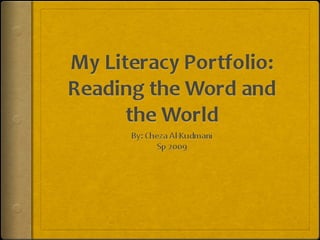Reading Portfolio
•Transferir como PPT, PDF•
1 gostou•3,149 visualizações
My Reading Journey!
Denunciar
Compartilhar
Denunciar
Compartilhar

Recomendados
The parable of the rainbow colors by juan m. flavier

The parable of the rainbow colors by juan m. flavierGovernor Feliciano Leviste Memorial National High School
Hazelnuts Packing, Transporting And Risk Factors

Hazelnuts Packing, Transporting And Risk FactorsSAMRIOGLU Hazelnuts, Dried Fruits and Chestnuts Export
Mais conteúdo relacionado
Mais procurados
The parable of the rainbow colors by juan m. flavier

The parable of the rainbow colors by juan m. flavierGovernor Feliciano Leviste Memorial National High School
Mais procurados (20)
The parable of the rainbow colors by juan m. flavier

The parable of the rainbow colors by juan m. flavier
Destaque
Hazelnuts Packing, Transporting And Risk Factors

Hazelnuts Packing, Transporting And Risk FactorsSAMRIOGLU Hazelnuts, Dried Fruits and Chestnuts Export
Dried Apricots Packing, Transporting And Risk Factors

Dried Apricots Packing, Transporting And Risk FactorsSAMRIOGLU Hazelnuts, Dried Fruits and Chestnuts Export
Destaque (11)
Dried Apricots Packing, Transporting And Risk Factors

Dried Apricots Packing, Transporting And Risk Factors
Último
Último (20)
Science 7 - LAND and SEA BREEZE and its Characteristics

Science 7 - LAND and SEA BREEZE and its Characteristics
18-04-UA_REPORT_MEDIALITERAСY_INDEX-DM_23-1-final-eng.pdf

18-04-UA_REPORT_MEDIALITERAСY_INDEX-DM_23-1-final-eng.pdf
Incoming and Outgoing Shipments in 1 STEP Using Odoo 17

Incoming and Outgoing Shipments in 1 STEP Using Odoo 17
Separation of Lanthanides/ Lanthanides and Actinides

Separation of Lanthanides/ Lanthanides and Actinides
Introduction to ArtificiaI Intelligence in Higher Education

Introduction to ArtificiaI Intelligence in Higher Education
TataKelola dan KamSiber Kecerdasan Buatan v022.pdf

TataKelola dan KamSiber Kecerdasan Buatan v022.pdf
A Critique of the Proposed National Education Policy Reform

A Critique of the Proposed National Education Policy Reform
Reading Portfolio
- 6. “ I am from…”